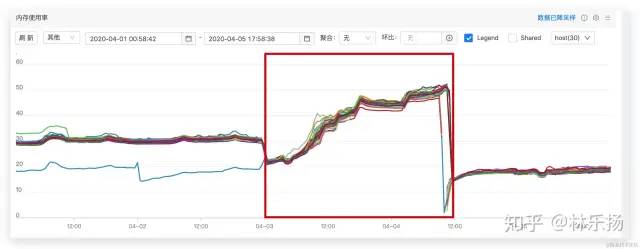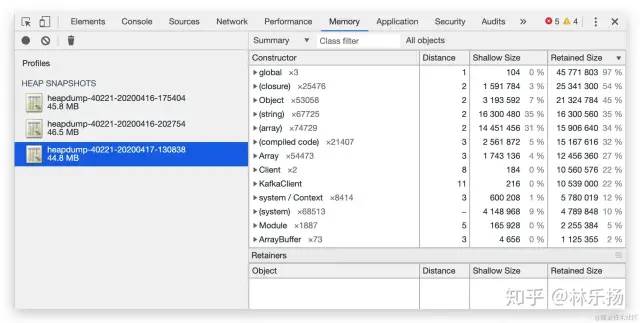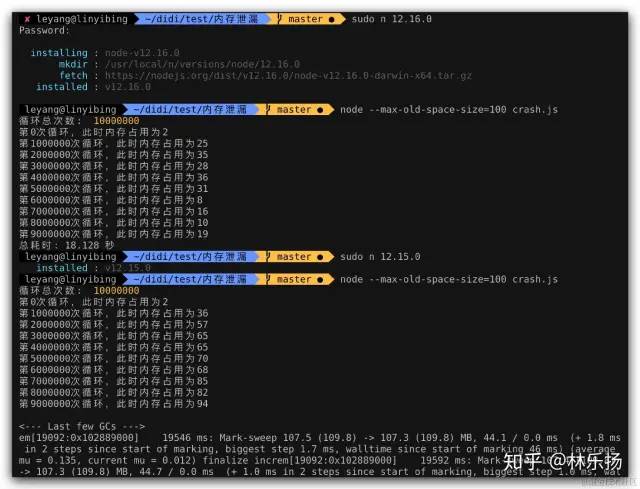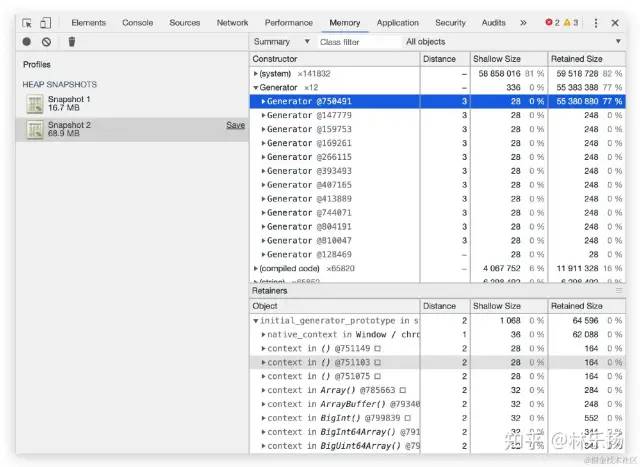排查 Node.js 服务内存泄漏,没想到竟是它?
今日文章由作者 @林乐扬 投稿分享。
背景
团队最近将两个项目迁移至 degg 2.0 中,两个项目均出现比较严重的内存泄漏问题,此处以本人维护的埋点服务为例进行排查。服务上线后内存增长如下图,其中红框为 degg 2.0 线上运行的时间窗口,在短短 36 小时内,内存已经增长到 50%,而平时内存稳定在 20%-30%,可知十之八九出现了内存泄漏。
排查思路
由于两个接入 degg 2.0 的服务均出现内存泄漏问题,因此初步将排查范围锁定在 degg 2.0引入或重写的基础组件上,重点怀疑对象为 nodex-logger 组件;同时为了排查内存泄漏,我们需要获取服务运行进程的堆快照(heapsnapshot),获取方式可参看文章 hyj1991:Node 案发现场揭秘 —— 快速定位线上内存泄漏https://zhuanlan.zhihu.com/p/36340263 。
排查过程
一、获取堆快照
使用 alinode 获取堆快照,服务启动后,使用小流量预热一两分钟便记录第1份堆快照(2020-4-16-16:52),接着设置 qps 为 125 对服务进行施压,经过大约一个小时(2020-4-16-15:46)获取第2份堆快照。使用 Chrome dev工具载入两份堆快照,如下图所示,发现服务仅短短运行一小时,其堆快照文件就增大了 45MB,而初始大小也不过 39.7MB;我们按 Retained Size 列进行排序,很快就发现了一个『嫌疑犯』,即 generator;该项占用了 55% 的大小,同时 Shallow Size 却为 0%,一项一项地展开,锁定到了图中高亮的这行,但是继续展开却提示 0%,线索突然断了。

generator 进入思考,我的服务代码并没有generator 语法,为什么会出现 generator 对象的内存泄漏呢?此时我把注意力转到 node_modules 目录中,由于最近一直在优化 nodex-kafka 组件,有时直接在 node_modules 目录中修改该组件的代码进行调试,因此几乎每个文件头部都有的一段代码引起了我的注意:
"use strict";
var __awaiter = (this && this.__awaiter) || function (thisArg, _arguments, P, generator) {
function adopt(value) { return value instanceof P ? value : new P(function (resolve) { resolve(value); }); }
return new (P || (P = Promise))(function (resolve, reject) {
function fulfilled(value) { try { step(generator.next(value)); } catch (e) { reject(e); } }
function rejected(value) { try { step(generator["throw"](value)); } catch (e) { reject(e); } }
function step(result) { result.done ? resolve(result.value) : adopt(result.value).then(fulfilled, rejected); }
step((generator = generator.apply(thisArg, _arguments || [])).next());
});
};这个代码是 typescript 源码编译后的产出,由于代码使用了 async/await 语法,因此都编译成 __awaiter 的形式,在源码中使用 async 函数的地方,在编译后都使用 __awaiter 进行包裹:
// 编译前
(async function() {
await Promise.resolve(1);
await Promise.resolve(2);
})()
// 编译后
(function () {
return __awaiter(this, void 0, void 0, function* () {
yield Promise.resolve(1);
yield Promise.resolve(2);
});
})();同时一个关于 generator 内存泄漏的 #30753 generator functions - memory leak https://github.com/nodejs/node/issues/30753 也引起了我的注意,该 issue 遇到的问题无论从 Node.js 的版本和内存泄漏的表现都和我遇到的问题十分相似。所以我在工程的 node_modules 中搜索所有 __awaiter 字符串,发现了 3 个模块编译出了上述代码,分别是:
- nodex-logger
- nodex-kafka
- nodex-apollo
由于模块的 tsconfig.json 的 target 字段将目标产出为es6,因此才会使用 generator 去模拟 async/await 语法,但是从 Node.js v8.10.0 开始已经 100% 支持了 ES2017 的所有特性,所以本不该编译 async/await 语法,此处遂将这 3 个模块的目标产出配置改为 es2017,这样 tsc 就不会编译 async/await 语法。
二、验证
重复之前获取堆快照的步骤,惊奇地发现即使过了一天,内存也没有增长,而且 generator 也没有持有未释放的内存:
至此,内存泄漏问题已经解决!那么如何避免遇到这个问题呢?
如何避免
一、解决步骤
步骤一
该问题仅在特定的 Node.js 版本中存在,请使用版本区间 (v11.0.0 - v12.16.0) 之外的 Node.js,从而防止二方 npm 组件、三方 npm 组件的 generator 语法使你的服务出问题
步骤二将自己的 typescript 的目标环境(target)编译为 es2017 及以上,同时应尽量使用 async/await 语法而不是 generator 语法,从而防止别人使用 (v11.0.0 - v12.16.0) 版本时,引入你的 npm 组件而导致内存泄漏
二、详细说明
前文说了从 Node.js v8.10.0 开始就已经支持了 async/await 语法,经查该版本于 2018-03-06 发布,由于所有服务也不可能一下全切换到新版本,因此为了兼容 Node.js v6 版本的环境,需要将代码编译到 es6。但是站在现在这个 LTS 版本已经是 v12 的时间节点,完全可以排查现有使用 typescript 的 npm 组件是否都编译到 es2017,甚至探讨编译到 es2019 的可能。
此外这个内存泄漏问题是从哪个版本开始有的,现在是否解决了呢?编写可验证的内存泄漏的代码如下:
// no-leak.js
const heapdump = require('heapdump')
class Async {
async run() {
return null;
}
}
const run = async () => {
for (let index = 0; index < 10000000; index++) {
if (index % 1000000 === 0)
console.log(Math.floor(process.memoryUsage().heapUsed / 10000), index);
const doer = new Async();
await doer.run();
}
heapdump.writeSnapshot((err, filename) => {
console.log("Heap dump written to", filename);
});
};
run();
// leak.js 由 no-leak.js 编译得来
var __awaiter = (this && this.__awaiter) || function (thisArg, _arguments, P, generator) {
function adopt(value) { return value instanceof P ? value : new P(function (resolve) { resolve(value); }); }
return new (P || (P = Promise))(function (resolve, reject) {
function fulfilled(value) { try { step(generator.next(value)); } catch (e) { reject(e); } }
function rejected(value) { try { step(generator["throw"](value)); } catch (e) { reject(e); } }
function step(result) { result.done ? resolve(result.value) : adopt(result.value).then(fulfilled, rejected); }
step((generator = generator.apply(thisArg, _arguments || [])).next());
});
};
class Async {
run() {
return __awaiter(this, void 0, void 0, function* () {
return null;
});
}
}
const run = () => __awaiter(this, void 0, void 0, function* () {
const now = Date.now();
console.log('循环总次数: ', 10000000);
for (let index = 0; index < 10000000; index++) {
if (index % 1000000 === 0) {
console.log('第 %d 次循环,此时内存为 %d', index, Math.floor(process.memoryUsage().heapUsed / 1000000));
}
const instance = new Async();
yield instance.run();
}
console.log('总耗时: %d 秒', (Date.now() - now) / 1000);
});
run();经过二分排查,发现该泄漏问题从 v11.0.0 引入,在 v12.16.0 解决;内存泄漏版本执行脚本时,内存占用逐步递增直到 crash,而未泄漏版本则会及时回收内存。
根本原因
根本原因是 v8 的一个 bug,相关链接:
v8 issue: https://bugs.chromium.org/p/v8/issues/detail?id=10031
v8 commit: https://chromium.googlesource.com/v8/v8.git/+/d3a1a5b6c4916f22e076e3349ed3619bfb014f29
node issue: https://github.com/nodejs/node/issues/30753
node commit: https://github.com/nodejs/node/pull/31005/files
改进后的代码,在分配新增WeakArrayList 数组时,即使返回没有空闲数组的标记( kNoEmptySlotsMarker ),仍需要调用 ScanForEmptySlots 方法重新扫描一次数组,因为该数组元素有可能有被 GC 回收,这些被回收的元素是可以重复使用的;仅当返回 kNoEmptySlotsMarker 且数组中没有被 GC 回收的元素,才真正执行新增逻辑:
// https://github.com/targos/node/blob/cceb2a87295724b7aa843363460ffcd10cda05b5/deps/v8/src/objects/objects.cc#L4042
// static
Handle<WeakArrayList> PrototypeUsers::Add(Isolate* isolate,
Handle<WeakArrayList> array,
Handle<Map> value,
int* assigned_index) {
int length = array->length();
if (length == 0) {
// Uninitialized WeakArrayList; need to initialize empty_slot_index.
array = WeakArrayList::EnsureSpace(isolate, array, kFirstIndex + 1);
set_empty_slot_index(*array, kNoEmptySlotsMarker);
array->Set(kFirstIndex, HeapObjectReference::Weak(*value));
array->set_length(kFirstIndex + 1);
if (assigned_index != nullptr) *assigned_index = kFirstIndex;
return array;
}
// If the array has unfilled space at the end, use it.
if (!array->IsFull()) {
array->Set(length, HeapObjectReference::Weak(*value));
array->set_length(length + 1);
if (assigned_index != nullptr) *assigned_index = length;
return array;
}
// If there are empty slots, use one of them.
int empty_slot = Smi::ToInt(empty_slot_index(*array));
if (empty_slot == kNoEmptySlotsMarker) {
// GCs might have cleared some references, rescan the array for empty slots.
PrototypeUsers::ScanForEmptySlots(*array);
empty_slot = Smi::ToInt(empty_slot_index(*array));
}
if (empty_slot != kNoEmptySlotsMarker) {
DCHECK_GE(empty_slot, kFirstIndex);
CHECK_LT(empty_slot, array->length());
int next_empty_slot = array->Get(empty_slot).ToSmi().value();
array->Set(empty_slot, HeapObjectReference::Weak(*value));
if (assigned_index != nullptr) *assigned_index = empty_slot;
set_empty_slot_index(*array, next_empty_slot);
return array;
} else {
DCHECK_EQ(empty_slot, kNoEmptySlotsMarker);
}
// Array full and no empty slots. Grow the array.
array = WeakArrayList::EnsureSpace(isolate, array, length + 1);
array->Set(length, HeapObjectReference::Weak(*value));
array->set_length(length + 1);
if (assigned_index != nullptr) *assigned_index = length;
return array;
}
// static
void PrototypeUsers::ScanForEmptySlots(WeakArrayList array) {
for (int i = kFirstIndex; i < array.length(); i++) {
if (array.Get(i)->IsCleared()) {
PrototypeUsers::MarkSlotEmpty(array, i);
}
}
}不止内存泄漏
在我测试内存泄漏时,有一个发现,执行发生内存泄漏时的代码(前文的 leak.js)和未发生内存泄漏时的代码(前文的 no-leak.js)时,即使在已经修复该问题的 Node.js v12.16.2 版本下,generator 语法仍然有两个问题:
- 内存回收效率低,导致执行完后,仍有相当大的内存占用;
- 执行效率非常慢,
async/await版本仅需要 0.953 秒,而generator却需要 17.754 秒;
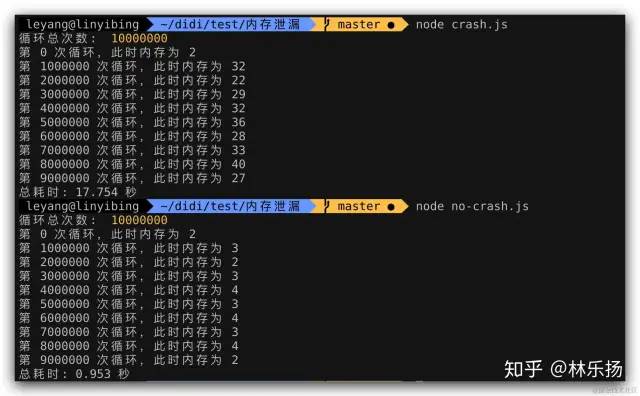
generator 语法,async/await 语法无论从执行效率还是内存占用方面都有压倒性优势。那么执行效率对比如何呢?上 benchmark 工具比划比划:
// benchmark.js
const __awaiter = (this && this.__awaiter) || function (thisArg, _arguments, P, generator) {
function adopt(value) { return value instanceof P ? value : new P(function (resolve) { resolve(value); }); }
return new (P || (P = Promise))(function (resolve, reject) {
function fulfilled(value) { try { step(generator.next(value)); } catch (e) { reject(e); } }
function rejected(value) { try { step(generator["throw"](value)); } catch (e) { reject(e); } }
function step(result) { result.done ? resolve(result.value) : adopt(result.value).then(fulfilled, rejected); }
step((generator = generator.apply(thisArg, _arguments || [])).next());
});
};
const Benchmark = require('benchmark');
const suite = new Benchmark.Suite;
suite
.add('generator', {
defer: true,
fn: function (deferred) {
(function () {
return __awaiter(this, void 0, void 0, function* () {
yield Promise.resolve(1);
yield Promise.resolve(2);
// 测试完成
deferred.resolve();
});
})();
}
})
.add('async/await', {
defer: true,
fn: function(deferred) {
(async function() {
await Promise.resolve(1);
await Promise.resolve(2);
// 测试完成
deferred.resolve();
})()
}
})
.on('cycle', function(event) {
console.log(String(event.target));
})
.run({
'async': false
});Node.js v12.16.2 的结果:
generator x 443,891 ops/sec ±4.12% (75 runs sampled)
async/await x 4,567,163 ops/sec ±1.96% (79 runs sampled)generator 每秒执行了 516,178 次操作,而 async/await 每秒执行了 4,531,357 次操作,后者是前者的 10 倍多!我们看看其它 Node.js 版本表现如何:
电脑配置:MacBook Pro (13-inch, 2017, Two Thunderbolt 3 ports)
二者执行效率和 Node.js 版本成正比,而 Node.js v12 来了一次大跃进,直接高了一个数量级,这个得益于 v8 7.2 的一个新特性,官网用了整整一篇文章 https://v8.dev/blog/fast-async#await-under-the-hood 说明,有兴趣的可以看看。
Chrome 也中招了吗?
目前最新版:版本 81.0.4044.113(正式版本) (64 位) 已经修复这个问题
既然是 v8 的问题,那么 chrome 浏览器也是有这个问题的,打开空白标签页,执行前文给出的 leak.js 代码:
